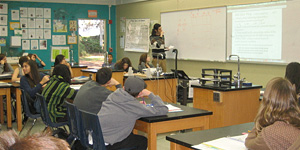By Jill Holiday | PCP PIRE K-12 outreach coordinator
On December 7 and 8, we followed up with our teachers (Gail Alaimo, Miriam Kaplan, Stacey Falls, Michael Lynch and Daniel Johnston) in Santa Cruz, California, about the ways that they have incorporated their new knowledge into their teaching. Bruce MacFadden, Jill Holliday, Cheryl McLaughlin, Gary Bloom and all of the teachers had a very productive meeting talking about how they have integrated what they learned in Panama. We also discussed ways to move forward with the project in the future, a possible follow-up in the spring and the selection criteria for the planned second cohort of teachers. During the conversations, all of the teachers reiterated how the Panama Project has dramatically changed the way they teach, particularly in that they have become much more inquiry-based in the classroom.

As we had hoped, teachers have taken what they learned and used it to reinvigorate their lessons and curricula. Gail Alaimo incorporated a new unit on sharks in her Oceanography class, including Megalodon. Stacey Falls says that while she hasn’t had a chance yet to directly use her fossils, she has carried over the idea of inquiry-based learning. She and a colleague created “mystery” boxes that students can manipulate, shake, tilt and weigh to try to determine what is actually inside. Such a simple concept, but it really encourages exploration as it sharpens reasoning and critical thinking skills. We were able to observe Mike Lynch use the fossil shells he collected in Panama for a class exercise on Mendelian genetics. Students were asked to select and draw two shells and then to describe physical traits of each shell–the phenotypes— so they had to distinguish tall vs. short, or ridged vs. smooth, or pointed vs. round. Students then converted the shell phenotypes to “genotypes” and performed monohybrid and dihybrid crosses using Punnett squares. Lastly, they determined the ratio and probability of different types of offspring. The students were completely engaged and worked hard on the assignment. We agreed it was a lot more effective to use real materials (and fossils!) rather than contrived examples such as candy or imaginary animals. Plus, students were able to touch, feel and decide on traits for themselves.
As a wrap-up, we all went to Seacliff Beach to look at Miocene age fossil deposits in the sandstone along the coast. Frank Perry, a local expert on the fossils, led the field trip and talked about what we were seeing and why we did –and did not– find particular organisms in specific places. The teachers were all very excited to learn about this wonderful resource so close to their schools. Everyone took lots of notes and plenty of brochures and it sounds like there will be some field trips happening very soon.
The assignments that have been created by the teachers so far are included on our Teacher Resources section.
Por Jill Holliday | Coordinadora de divulgación escolar del PCP PIRE
El 7 y 8 de diciembre realizamos una visita a nuestros profesores (Gail Alaimo, Kaplan Miriam, Falls Stacey, Michael Lynch y Daniel Johnston) en Santa Cruz, California, para conocer las formas en que ellos han incorporado nuevos conocimientos en su práctica de enseñanza. Bruce MacFadden, Jill Holliday, Cheryl McLaughlin, Gary Bloom y todos los profesores tuvieron una reunión muy productiva hablando de cómo han integrado lo que aprendieron en Panamá. También hablamos sobre la manera de avanzar el proyecto en el futuro, un seguimiento adicional durante el semestre y los criterios de selección para la segunda cohorte de docentes. Durante las conversaciones, todos los maestros reiteraron como el Proyecto de Panamá ha cambiado dramáticamente la forma en que enseñan, sobre todo en la incorporación de la indagación-guiada en el aula.

Como esperábamos, los maestros han tomado lo que han aprendido y lo han usado para revitalizar sus lecciones y planes de estudio. Gail Alaimo incorporó una nueva unidad sobre los tiburones en su clase de Oceanografía, incluyendo al Megalodón. Stacey Falls, dice que, si bien no ha tenido aún la oportunidad de utilizar directamente sus fósiles, ha empleado más la idea del aprendizaje por indagación. Ella y su colega crearon cajas “misteriosas” con la que los estudiantes pueden manipular, mover, inclinar y pesar para tratar de determinar lo que en realidad hay en su interior. Un concepto simple, pero que fomenta la exploración agudizando el razonamiento y el pensamiento crítico. Pudimos observar como Mike Lynch utilizó las conchas fósiles colectadas en Panamá para realizar un ejercicio de clase sobre genética mendeliana. Los estudiantes seleccionaron y dibujaron dos conchas y luego describieron las características físicas de cada una (los fenotipos). De este modo distinguieron entre alto vs. corto, puntiagudas vs. lisas, o puntiaguda vs. redondeada. Luego, los estudiantes convirtieron los fenotipos de las conchas en “genotipos” y realizaron cruces monohíbridos y dihíbridos usando el cuadro de Punnett. Por último, determinaron la relación y la probabilidad de los diferentes tipos de descendencia. Los estudiantes estuvieron muy comprometidos y trabajaron duro en la tarea. Estuvimos de acuerdo en que era mucho más efectivo utilizar materiales reales (¡y fósiles!) en lugar de ejemplos rebuscados como dulces o animales imaginarios. Además, los estudiantes pudieron tocar, sentir y decidir por sí mismos los diferentes rasgos.
Para resumir, nos fuimos todos a la playa Seacliff para observar depósitos fósiles del Mioceno en la piedra arenisca a lo largo de la costa. Frank Perry, un experto local en fósiles, encabezó la visita de campo y habló de lo que estábamos viendo y por qué podíamos encontrar ciertos organismos en lugares específicos. Los profesores estaban muy emocionados de conocer este maravilloso recurso tan cerca de sus escuelas. Todos ellos tomaron muchas notas y se llevaron folletos. Tal parece que habrá algunas excursiones muy pronto.